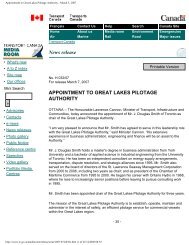2012 - Great Lakes Pilot Authority, Canada
2012 - Great Lakes Pilot Authority, Canada
2012 - Great Lakes Pilot Authority, Canada
You also want an ePaper? Increase the reach of your titles
YUMPU automatically turns print PDFs into web optimized ePapers that Google loves.
1. <strong>Authority</strong> and objectives<br />
The <strong>Great</strong> <strong>Lakes</strong> <strong>Pilot</strong>age <strong>Authority</strong>, Ltd. (The <strong>Authority</strong>) was established in February 1972 pursuant to the <strong>Pilot</strong>age Act,<br />
incorporated as a limited company in May 1972, and was continued under the <strong>Canada</strong> Business Corporations Act.<br />
Until October 1st, 1998, it operated under the name of <strong>Great</strong> <strong>Lakes</strong> <strong>Pilot</strong>age <strong>Authority</strong>, Ltd. and was a subsidiary of the<br />
St. Lawrence Seaway <strong>Authority</strong>. Pursuant to the <strong>Canada</strong> Marine Act, which received Royal Assent on June 11, 1998,<br />
the name of the <strong>Authority</strong> was changed to <strong>Great</strong> <strong>Lakes</strong> <strong>Pilot</strong>age <strong>Authority</strong> and the <strong>Authority</strong> was deemed to have been<br />
established under subsection 3(1) of the <strong>Pilot</strong>age Act. The <strong>Authority</strong> is a Crown corporation listed in Schedule III, Part I<br />
of the Financial Administration Act.<br />
The objectives of the <strong>Authority</strong> are to establish, operate, maintain and administer a safe and efficient pilotage service<br />
within designated Canadian waters.<br />
The <strong>Authority</strong> is exempt from any income taxes.<br />
The principal registered address and records office of the <strong>Authority</strong> are located at 202 Pitt Street, 2nd floor, Cornwall,<br />
Ontario.<br />
Regulation of tariff of pilotage charges<br />
Notes to the Financial Statements<br />
December 31, <strong>2012</strong><br />
(In Canadian dollars)<br />
The <strong>Authority</strong> shall, with the approval of the Governor in Council, make regulations prescribing tariffs of pilotage charges<br />
to be paid to that <strong>Authority</strong>. The tariff approval process is set out in the <strong>Pilot</strong>age Act. Consequently, the <strong>Authority</strong> must first<br />
publish the proposed tariff regulation in the <strong>Canada</strong> Gazette. Any person who has reason to believe that a regulation<br />
in this proposal is not in the public interest may file a notice of objection, setting out the grounds therefore, with the<br />
Canadian Transportation Agency (Agency) within thirty days following publication of the proposed regulation in the<br />
<strong>Canada</strong> Gazette. In such a case, the Agency must investigate the proposed regulation as necessary or desirable in the<br />
public interest, including the holding of public hearings. Once its investigation is complete, the Agency must make a<br />
recommendation within 120 days following the receipt of notices of objection, and the <strong>Authority</strong> is required to govern itself<br />
accordingly. The Agency is an entity related to the <strong>Authority</strong> as an organization of the federal government.<br />
The tariffs may come into force 30 days after their publication in the <strong>Canada</strong> Gazette. However, where the Agency<br />
recommends a pilotage charge that is lower than that fixed by the <strong>Authority</strong>, the <strong>Authority</strong> is required to reimburse the<br />
difference between this charge and the charge recommended by the Agency, plus interest, to any person who has paid<br />
the fixed charge. The <strong>Pilot</strong>age Act stipulates that the Governor in Council may amend or cancel a recommendation of the<br />
Canadian Transportation Agency.<br />
The tariffs of pilotage charges must be fair and reasonable, and must enable the <strong>Authority</strong> to operate on a self-sustaining<br />
financial basis. Thus, the tariffs fixed are intended to allow the <strong>Authority</strong> to recover costs.<br />
2. Basis of presentation<br />
(a) Declaration of conformity<br />
These financial statements, including comparatives, have been prepared in compliance with International Financial<br />
Reporting Standards (“IFRS”) as issued by the International Accounting Standards Board (“IASB”). The financial statements<br />
were approved by the Board of Directors on February 27, 2013.<br />
20<br />
<strong>2012</strong> Annual Report







